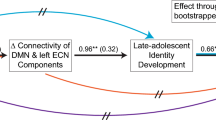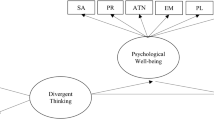Abstract
The purpose of this study was to explore the relationship between divergent thinking and self-esteem in preadolescents and adolescents. A second focus pertained to sex differences in the dependent variables. A total of 115 White middle class subjects ranging in age from 10–17 years responded to a personal data inventory, a self-esteem measure, and a taped auditory free-response exercise in divergent thinking. Subjects were categorized for data analysis into two age groups, preadolescents and adolescents. Scores were obtained for fluency, flexibility, and originality of thought, and for self-esteem. Adolescents were significantly more fluent and flexible than preadolescents. The two age groups did not differ significantly in orginality or self-esteem. Self-esteem correlated significantly with divergent thinking in preadolescents only. Female adolescents scored significantly higher on all dependent measures than adolescent males; there were no sex differences in preadolescents. Results are discussed from both an intra- and interstage developmental perspective on adolescence.
Similar content being viewed by others
References
Arasteh, A. R. (1968).Creativity in the Life Cycle, E. J. Brill, Leiden, Netherlands.
Baltes, P. B., and Nesselroade, J. R. (1972). Cultural change and adolescent personality development: An application of longitudinal sequences.Dev. Psychol. 7: 244–256.
Birren, J. E., and Morrison, D. F. (1961). Analysis of the WAIS subtests in relation to age and education.J. Gerontol. 16: 363–369.
Coopersmith, S. (1959). A method for determining two types of self-esteem.J. Abnorm. Soc. Psychol. 59: 87–94.
Coopersmith, S. (1967).The Antecedents of Self-Esteem, W. H. Freeman, San Francisco.
Cunnington, B. F., and Torrance, E. P. (1965).Sounds and Images, Ginn, Lexington, Mass.
Dickstein, E. (1977). Self and self-esteem: Theoretical foundations and their implications for research.Hum. Dev. 20: 129–140.
Eichorn, D. H. (1973). The Berkeley longitudinal studies: Continuities and correlates of behavior.Canad. J. Behav. Sci. 5: 297–320.
Guilford, J. P. (1967).The Nature of Human Intelligence, McGraw-Hill, New York.
Horrocks, J. E. (1976).The Psychology of Adolescence, 4th ed., Houghton Mifflin, Boston.
Jaquish, G. A., and Ripple, R. E. (1980). Cognitive abilities and self-esteem across the adult life-span.Hum. Dev. (in press).
Khatena, J., and Torrance, E. P. (1973).Thinking Creatively with Sounds and Words, Ginn, Lexington, Mass.
Levinson, D. (1978).The Seasons of a Man's Life, Knopf, New York.
Maccoby, E. E., and Jacklin, C. N. (1974).The Psychology of Sex Differences, Stanford University Press, Stanford, Calif.
Prawat, R. S., Jones, H., and Hampton, J. (1979). Longitudinal study of attitude development in pre-, early, and later adolescent samples.J. Educ. Psychol. 71(3): 363–369.
Rosenberg, M. (1965).Society and the Adolescent Self-Image, Princenton University Press, Princenton, N.J.
Thornburg, H. D. (1974).Preadolescent Development, University of Arizona Press, Tucson, Arizona.
Author information
Authors and Affiliations
Additional information
Research assistant and doctoral canditate in human developmental and family studies at Cornell University. Major interests are adolescent and human life-span development.
Received his Ph.D. from the University of Wisconsin. Major interests are the study of creativity and the educational psychology of human life-span development.
Rights and permissions
About this article
Cite this article
Jaquish, G.A., Ripple, R.E. Divergent thinking and self-esteem in preadolescents and adolescents. J Youth Adolescence 9, 143–152 (1980). https://doi.org/10.1007/BF02087932
Received:
Issue Date:
DOI: https://doi.org/10.1007/BF02087932




